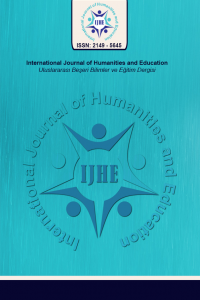TÜRK DESTAN YARATICILIĞINDA KAN ARKETİPİNİN SEMANTİK ÇEŞİTLİLİĞİ
Makale, Türk halklarının geçmişini ve bugününü temsil eden "Oğuz Kağan", "Alp er Tunga", "Dede Korkut Destanı", "Manas" vb. destanlardaki "kan" arketipini tanımlamaktadır. Bu arketipin en karakteristik özellikleri incelenmiş, genetik ve türsel özellikleri Türk destanlarına referansla araştırılmış, konumu, anlamsal yükü, statüsü ve tonları belirlenmiş ve bilimsel bilgilerden yararlanılarak değerlendirilmiştir. Biyolojik varoluşun temel maddesi olan kan, koruyucu ve kutsal işlevleriyle yaratılışı sembolize eder. Kırmızı rengin sembolü olan kan, doğumu ve ölümü, zihnin ve duyguların gücünü temsil eder, beden ve ruhun, iyi ve kötünün birliği. Örneğin Dede Korkut destanında "kanlı gömlek" ölümün sembolüyken, kırmızı eşarp ve kırmızı peçe mutlu bir geleceğin sembolü haline gelir. Aynı şey «kan davası», «kan davası», «kan hısımlığı», «kan hakkı», «kan yemini», «insan kurbanı» vb. kavramlara da atıfta bulunmaktadır. Tüm bu motifler kan kavramına ve onu temsil eden kırmızı rengin anlamsal spektrumuna dayanmaktadır. Yazar, bu arketipin belirli epik olay örgülerinde taşıdığı anlamı, yani taşıdığı anlam yükünü ele alıyor. Kan akrabalığı, kan intikamı, kan kardeşliği, kan yeminleri gibi birçok motifin oluşturduğu yelpaze, halkımızın yüzyıllardır süregelen manevi değerleri ve dünya görüşünü somutlaştırmaktadır. Kan motiflerinin spektrumundan bahsettiğimizde, yukarıdaki anlamda kanın önemini, taşıdığı anlam yükünü kastediyoruz. Bu, kırmızının, beyaz spektrumun temel renklerinden biri olan ve aynı zamanda kan rengi olarak da bilinen semantik anlamıyla daha fazla ilişkilidir. Kırmızı renk, dünyaya hayat veren güneşin rengi ve insana hayat veren temel elementin rengidir.
Anahtar Kelimeler:
kan, türk destanı, spektrum, arketip, kırmızı renk
SEMANTIC SPECTRUM OF THE BLOOD ARCHETYPE IN TURKISH EPIC CREATIVITY
The article includes articles such as "Oğuz Kağan", "Alp er Tunga", "Dede Korkut Epic", "Manas", etc., which represent the past and present of the Turkish people. It defines the "blood" archetype in epics. The most characteristic features of this archetype have been examined, its genetic and generic features have been investigated with reference to Turkish epics, its location, semantic load, status and tones have been determined and evaluated using scientific information. Blood, the basic substance of biological existence, symbolizes creation with its protective and sacred functions. Blood, the symbol of the color red, represents birth and death, the power of the mind and emotions, the unity of body and soul, good and evil. For example, in the Dede Korkut epic, the "bloody shirt" is a symbol of death, while the red scarf and red veil become symbols of a happy future. The same goes for 'blood feud', 'blood feud', 'blood kinship', 'blood right', 'blood oath', 'human sacrifice', etc. It also refers to concepts. All these motifs are based on the concept of blood and the semantic spectrum of the color red that represents it. The author discusses the meaning that this archetype carries in certain epic plots, that is, the semantic load it carries. The range of motifs such as blood kinship, blood revenge, blood brotherhood, blood oaths embodies the spiritual values and worldview of our people that have existed for centuries. When we talk about the spectrum of blood motifs, we mean the importance of blood in the above sense, the semantic load it carries. This is more related to the semantic meaning of red, which is one of the basic colors of the white spectrum and is also known as the color of blood. Red color is the color of the sun that gives life to the world and the color of the basic element that gives life to humans.
Keywords:
blood, turkish epic, spectrum, archetype, red color,
- Başlangıç: 2015
- Yayıncı: Halil TURGUT
Sayıdaki Diğer Makaleler
Sürdürülebilir Kalkınma Suç ve Sosyal Hizmet
Algısal Etimoloji. Etimolojik Araştırmanın Sosyal Bir Yönü
TÜRK DESTAN YARATICILIĞINDA KAN ARKETİPİNİN SEMANTİK ÇEŞİTLİLİĞİ
Çevirmen: Muhammed Göktürk KORKMAZ
Destanlar Işığında Türk ve Moğol Halklarında Büyü
Murat KORKMAZ, Zümral GÜLTEKİN
Medya Unsurlarının Destinasyon Tanıtımına Etkisi: Sinop Tarihi Cezaevi Örneği
Vergi Gelirleri ve Ekonomik Büyüme: Panel Kantil Regresyon Analizinden Kanıtlar
Örgüt Yönetimlerinde Pazarlama Araştırmaları Açısından Kültürel Kodlar ve Küreselleşmenin Etkileri
Örgütsel Kimliğe Eleştirel Bir Bakış: Örgütlenme Sürecine İlişkin Anlayışımızı Nasıl Etkiler?
